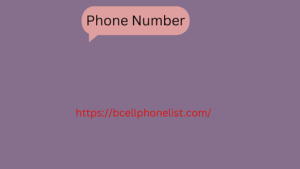In our interconnected world, the humble phrase “telephone number to” carries immense significance. It serves as a gateway, directing calls to their intended destinations. This comprehensive guide delves into the anatomy of a phone number, explores the concept of “to” in the context of calling, and discusses alternative communication methods that might replace traditional phone calls in the future.
Breaking Down the Basics: Unveiling the Phone Number (350 Words)
A typical phone number consists of various parts, working singapore phone numbers list together to route a call:
Country Code (1-2 digits): This prefix identifies the nation associated with the phone number (e.g., “1” for the US and Canada).
Area Code (3 digits): Historically, this segment served as a geographic identifier, routing calls to a specific region. However, with mobile phone prevalence and overlays (assigning multiple area codes to a single area), the geographic correlation is weakening.
Local Phone Number (7 digits): This unique combination identifies a specific phone line within the designated area code.
Therefore, a standard phone number typically comprises 10 digits (country code + area code + local phone number).
The Significance of “To”: Connecting the Dots (400 Words)
“Telephone number to” precedes the actual phone Yeezys Shoes number, signifying the destination of the call. It acts as a verbal or written instruction, informing the recipient (or dialing system) where the call should be directed. Here’s how it functions:
Direct Dialing: When manually dialing a phone number, we precede the digits with “telephone number to” or simply “to” (e.g., “Telephone number to dial: 555-1234”).
Contact Information: In written communication, “telephone number to” is often used before listing contact details (e.g., “For inquiries, please call telephone number to 1-800-FLOWERS”).
Digital Assistants: Smart speakers and virtual assistants like Siri and Google Assistant might require the “telephone number to” prompt before initiating a call using voice commands (e.g., “Hey Siri, call telephone number to 212-555-1212”).
Beyond the Dial Pad: Alternative Communication Methods (400 Words)
The digital age has introduced various communication channels beyond traditional phone calls:
Email and Messaging Apps: Email and platforms like WhatsApp, Telegram, and Signal offer text-based communication, often with features like file sharing and group chats.
Video Conferencing: Tools like Zoom, Google Meet, and Microsoft Teams allow real-time video calls, ideal for meetings and collaborative work.
Social Media: Platforms like Facebook and Instagram allow direct messaging between users, providing another avenue for communication.
While phone numbers remain relevant, these alternative methods highlight a shift in how we connect.
The Future of Communication: Beyond “Telephone Number To” (400 Words)
As technology evolves, the way we initiate communication might surpass the need for a specific “telephone number to”:
Smart Devices and Voice Assistants: Smartphones with voice assistants might leverage voice commands to replace traditional dialing. Imagine saying, “Call John Smith” instead of needing his phone number.
Context-Aware Communication: Future systems might intelligently suggest the most suitable communication method based on context and user preferences. For example, a business call might initiate a video conference automatically.
Integrated Platforms: Communication might become seamless and integrated within existing platforms. Emailing a contact might offer an option to initiate a call or video chat directly.
Conclusion: A Bridge Between Past and Future (200 Words)
The phrase “telephone number to” serves as a cornerstone of traditional communication. Understanding the structure of phone numbers and the significance of “to” empowers us to navigate the current communication landscape effectively.
However, the future holds exciting possibilities for more intuitive and contextual communication methods. As technology advances, “telephone number to” might become a relic of the past, replaced by a more automated and personalized approach to connecting with others.
